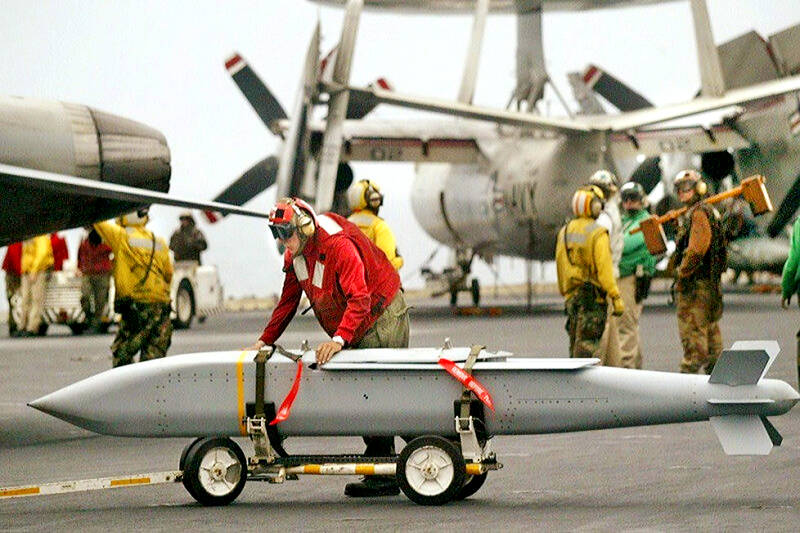The US Department of Defense is to partner with RTX Corp, formerly Raytheon Technologies Corp, to deliver 50 AGM-154 Joint Standoff Weapons (JSOW), or glide bombs, to Taiwan over the next four years, a report published on Friday showed.
The report, published on the department’s Web site on Friday, said that 50 AGM-154 Block III C JSOWs would be delivered to Taiwan under a fixed-price contract worth US$68.4 million.
Most of the production of the weapons would be done in Tucson, Arizona, and would be completed by March 2028, the report said.

Photo: AFP
The report comes after Reuters on Thursday quoted US officials as saying that the US military had left equipment in Australia following last year’s Talisman Sabre 23 joint exercise, with the intention that it could be used by US forces in the event of a conflict with China over Taiwan.
The glide bombs are part of a larger arms package of seven items initially announced by the US in June 2017. It also included the AGM-88 HARM (High-speed Anti-radiation Missile) and other weapons that could be used with Taiwan’s F-16 jets. The weapons were intended to complement other upgrades to Taiwan’s F-16 fleet, which also included radar and communications system upgrades.
The AGM-154 is a JSOW that emerged through the US Navy’s Advanced Interdiction Weapon System program launched in 1987, which sought to develop weapons that are usable day or night, and in any weather conditions.
The JSOWs designed for the program are “fire and forget” weapons, meaning they do not require external guidance after launch. Instead, they navigate to their targets via a GPS/inertial navigation system. JSOW weapons have been replacing conventional laser-guided bombs, and the newest JSOW weapons also incorporate infrared guidance systems.
JSOW weapons dropped at high altitude can reach targets as far as 110km away, and those launched at low altitude can strike up to 22km away, which would enhance the F-16 jet’s land attack capabilities.
Countries other than the US that are purchasing AGM-154 glide bombs include Taiwan, Australia, Finland, Greece, Poland, Singapore and Turkey.
Taiwan has facilitated the incorporation of the weapons into its fleet by upgrading its older F-16A/B fighter jets to the F-16V variant through the Phoenix Rising Project and through the purchase of newer Block 70 fighters.
The upgraded jets as well as the Block 70 fighters can carry AGM-154C glide bombs, which could help diversify the Taiwanese air force’s air-to-ground combat capabilities.

A car bomb killed a senior Russian general in southern Moscow yesterday morning, the latest high-profile army figure to be blown up in a blast that came just hours after Russian and Ukrainian delegates held separate talks in Miami on a plan to end the war. Kyiv has not commented on the incident, but Russian investigators said they were probing whether the blast was “linked” to “Ukrainian special forces.” The attack was similar to other assassinations of generals and pro-war figures that have either been claimed, or are widely believed to have been orchestrated, by Ukraine. Russian Lieutenant General Fanil Sarvarov, 56, head

SAFETY FIRST: Double the number of police were deployed at the Taipei Marathon, while other cities released plans to bolster public event safety Authorities across Taiwan have stepped up security measures ahead of Christmas and New Year events, following a knife and smoke bomb attack in Taipei on Friday that left four people dead and 11 injured. In a bid to prevent potential copycat incidents, police deployments have been expanded for large gatherings, transport hubs, and other crowded public spaces, according to official statements from police and city authorities. Taipei Mayor Chiang Wan-an (蔣萬安) said the city has “comprehensively raised security readiness” in crowded areas, increased police deployments with armed officers, and intensified patrols during weekends and nighttime hours. For large-scale events, security checkpoints and explosives

‘POLITICAL GAME’: DPP lawmakers said the motion would not meet the legislative threshold needed, and accused the KMT and the TPP of trivializing the Constitution The Legislative Yuan yesterday approved a motion to initiate impeachment proceedings against President William Lai (賴清德), saying he had undermined Taiwan’s constitutional order and democracy. The motion was approved 61-50 by lawmakers from the main opposition Chinese Nationalist Party (KMT) and the smaller Taiwan People’s Party (TPP), who together hold a legislative majority. Under the motion, a roll call vote for impeachment would be held on May 19 next year, after various hearings are held and Lai is given the chance to defend himself. The move came after Lai on Monday last week did not promulgate an amendment passed by the legislature that

PENTAGON ASSESSMENT: A US report said that even as China and Russia deepen their partnership, cooperation is hindered by a ‘mutual distrust’ of each other The Chinese People’s Liberation Army (PLA) as of October had doubled the number of ships and airplanes deployed around Taiwan compared with the previous two years, Vice Minister of National Defense Hsu Szu-chien (徐斯儉) said yesterday, a day after the opposition-controlled legislature voted against reviewing the government’s general budget for next year, including a NT$1.25 trillion (US$39.71 billion) special defense spending bill. The legislature’s vote against the Ministry of National Defense’s spending plans was regrettable, as the budget was designed to respond to the developing Chinese military threat, Hsu said on the sidelines of a legislative meeting on the general budget. Defense